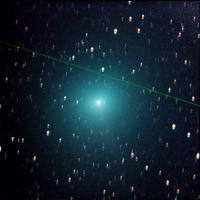Ancient myths suggest that a giant comet may have visited the Earth a few thousand years ago, raining fireballs and meteorsScientists are starting to recognise that the evolution of life on Earth has been affected, if not largely shaped, by its celestial environment. We now recognise that throughout its history the Earth has been bombarded by comets, small asteroids, meteorites (small rocky or iron bodies) and smaller particle and dust (meteor) showers. Over the years, astronomers have detected a substantial population of such small bodies out there in the Solar System, confirming that the threat of their impact with the Earth is a significant one. Current estimates, for example, suggest that between 10 and 30 impacts similar to the one that occurred in Tunguska in Siberia in 1908 have happened over recorded history, with perhaps one or more exploding with a force equivalent to that produced by 500 to 1000 megatonnes of TNT.

|
| ©Frontiers
|
| A mediæval representation of a meteorite fall as a serpent in the sky
|

